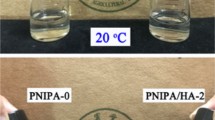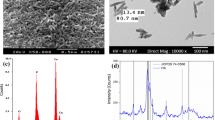Abstract
Well-defined “smart” injectable hydrogel based on hydrophilic poly(ethylene glycol) (PEG) and hydrophobic poly(lactic acid-co-glycolic acid) (PLA/PGA) copolymer (PLGA-PEG-PLGA) gelling at the body temperature was modified by bioactive hydroxyapatite (HAp) in the form of micro-, nano-, and core-shell particles (μ-HAp, n-HAp, and CS-x, respectively) to be applicable as calcium delivery system in bone regeneration. Viscoelastic moduli increased with HAp content as expected. Whereas systems containing μ-HAp or CS-x particles maintained two sol-gel and gel-sol phase transitions, the n-HAp containing system showed only one sol-gel phase transition due to the strong interactions between polymer chain and the n-HAp surface. In vitro, studies proved the controlled uniform release of calcium cations from both CS-x and n-HAp over the 9-day period without any initial burst release.













Similar content being viewed by others
References
Fu S, Guo G, Gong C, Zen S, Liang H, Luo F, Zhang X, Zhao X, Wei Y, Qian Z (2009) Injectable biodegradable thermosensitive hydrogel composite for orthopedic tissue engineering. 1. Preparation and characterization of nanohydroxyapatite/poly(ethylene glycol)-poly(ε-caprolactone)-poly(ethylene glycol) hydrogel nanocomposites. J Phys Chem B 113:16518–16525. doi:10.1021/jp907974d
Jeong B, Kim SW, Bae YH (2002) Thermosensitive sol-gel reversible hydrogels. Adv Drug Deliv Rev 54:37–51. doi:10.1016/S0169-409X(01)00242-3
Freiberg S, Zhu XX (2004) Polymer microspheres for controlled drug release. Int J Pharm 282:1–18. doi:10.1016/j.ijpharm.2004.04.013
Makadia HK, Siegel SJ (2011) Poly lactic-co-glycolic acid (PLGA) as biodegradable controlled drug delivery carrier. Polymers 3:1377–1397. doi:10.3390/polymer3031377
E. Jančářová (2014). Structure and properties of collagen/HAp nanocomposites network. Doctoral thesis. Brno
Sasaki S, Ishii Y (1999) Apatite cements containing antibiotics: efficacy in treating experimental osteomyelitis. Journal Orthopaedic Science 4:361–369. doi:10.1007/s007760050117
Schnieders J, Gbureck U, Thull R, Kissel T (2006) Controlled release of gentamicin from calcium phosphate-poly(lactic-co-glycolic acid) composite bone cement. Biomaterials 27:4239–4249. doi:10.1016/j.biomaterials.2006.03.032
Fullana SG, Ternet H, Freche M, Rodriguez F (2010) Controlled release properties and final macroporosity of pectin microspheres-calcium phosphate composite bone cements. Acta Biomater 6:2294–2300. doi:10.1016/j.actbio.2009.11.019
Otsuka M, Nakagawa H, Ito A, Higuchi WI (2010) Effect of geometrical structure on drug release rate of a three-dimensionally perforated porous apatite/collagen composite cement. J Pharm Sci 99:286–292. doi:10.1002/jps.21835
Tani T, Okada K, Takahashi S, Suzuki N, Shimada Y, Itoi E (2006) Doxorubicin-loaded calcium phosphate cements in the management of bone and soft tissue tumors. In Vivo 20:55–60
Schnitzler V, Fayon F, Despas C, Khairoun I, Mellier C, Rouillon T, Massiot D, Walcarius A, Janvier P, Gauthier O, Montavon G, Bouler. JM, Bujoli B (2011) Investigation of alendronate-doped apatitic cements as a potential technology for the prevention of osteoporotic hip fractures: critical influence of the drug introduction mode on the in vitro cement properties. Acta Biomater 7:759–770. doi:10.1016/j.actbio.2010.09.017
de Boer HH (1988) The history of bone grafts. Clin Orthop Relat Res 226:292–298
Vacanti CA, Kim W, Upton J, Vacanti MP, Mooney D, Schloo B, Vacanti JP (1993) Tissue-engineered growth of bone and cartilage. Transplantation Proceeding 25:1019–1021
Osman MA, Atallah A, Schweizer T, Ӧttinger HCH (2004) Particle–particle and particle-matrix interactions in calcite filled high-density polyethylene—steady shear. J Rheol 48:1167. doi:10.1122/1.1784782
R.A. Hule, D.J. Pochan. Polymer nanocomposites for biomedical application. MRS Buletin 32 (2007). doi: 10.1557/mrs2007.235
Ye L, Chu X, Zhang Z, Kan Y, Xie Y, Grillo I, Zhao J, Dreiss CA, Qiu D (2014) Effect of particles polydispersity on the structure and dynamics of complex formation between small particles and large polymer. RCS Advances 4:14896
Částková K, Hadraba H, Matousek A, Roupcová P, Chlup Z, Novotná L, Cihlář J (2016) Synthesis of Ca,Y-zirconia/hydroxyapatite nanoparticles and composites. Journal of the European Ceramic Society 36:2903–2912. doi:10.1016/j.jeurceramsoc.2015.12.045
Michlovská L, Vojtová L, Mravcová L, Hermanová S, Kučerík J, Jančář J (2010) Functionalization conditions of PLGA-PEG-PLGA copolymer with itaconic anhydride. Macromol Symp 295:119–124. doi:10.1002/masy.200900071
Nakajima N, Ikada Y (1995) Mechanisms of amide formation by carbodiimide for bioconjugation in aqueous media. Bioconjug Chem 6:123–130
I. Chamradová (2015) Polymeric materials for the controlled drug release and controlled release of active substances. Doctoral Thesis. Brno
Chen L, Mccrate JM, Lee JC, Li H (2011) The role of surface charge on the uptake and biocompatibility of hydroxyapatite nanoparticles with osteoblast cells. Nanotechnology 22:105708. doi:10.1088/0957-4484/22/10/105708
Chamradová I, Vojtová L, Michlovská L, Poláček P, Jančář J (2011) Rheological properties of functionalised thermosensitive copolymers for injectable applications in medicine. Chem Pap 66:977–980. doi:10.2478/s11696-012-0210-y
Kumar R, Kalur GC, Ziserman L, Danino D, Raghavan SR (2007) Wormlike micelles of a C22-tailed zwitterionic betaine surfactant: from viscoelastic solutions to elastic gels. Langmuir 23:12849–12856. doi:10.1021/la7028559
Hashizaki K, Taguchi H, Saito Y (2009) Effects of temperature on the rheological behavior of worm-like micelles in a mixed nonionic surfactant system. Journal of Oleo Science 58(5):255–260. doi:10.5650/jos.58.255
Kalfus J, Jančář J (2007) Elastic response of nanocomposite poly(vinylacetate)-hydroxyapatite with varying particles shape. Polym Compos 28:365–371. doi:10.1002/pc.20273
Raghavan SR, Douglas JF (2012) The conundrum of gel formation by molecular nanofibers, wormlike micelles and filamentous proteins: gelation without cross-links? Soft Materials 8:8539–8546. doi:10.1039/c2sm25107h
Acknowledgements
This research was carried out under the project CEITEC 2020 (LQ1601) with financial support from the Ministry of Education, Youth and Sports of the Czech Republic under the National Sustainability Programme II and FP7 project no. 60436 named “BioScaffolds”. We acknowledge the CF Cryo-electron Microscopy and Tomography supported by the CIISB research infrastructure (LM2015043 funded by MEYS CR) for their support with obtaining scientific data presented in this paper.
Author information
Authors and Affiliations
Corresponding author
Ethics declarations
Statement of disclosure
This study was funded by CEITEC 2020 (LQ1601) with financial support from the Ministry of Education, Youth and Sports of the Czech Republic under the National Sustainability Programme II (grant number LQ1601) and MEYS CR (grant number LM2015043).
Authors Ivana Chamradova, Lucy Vojtová, Josef Jančář, and Pavel Diviš have received research grants from CEITEC 2020 (grant number LQ1601). Author Miroslav Peterek has received research grant from MEYS CR (grant number LM2015043) and Klára Částková FP7 project No. 60436 named “BioScaffolds”.
Conflict of interest
The authors declare that they have no conflict of interest.
Rights and permissions
About this article
Cite this article
Chamradová, I., Vojtová, L., Částková, K. et al. The effect of hydroxyapatite particle size on viscoelastic properties and calcium release from a thermosensitive triblock copolymer. Colloid Polym Sci 295, 107–115 (2017). https://doi.org/10.1007/s00396-016-3983-7
Received:
Revised:
Accepted:
Published:
Issue Date:
DOI: https://doi.org/10.1007/s00396-016-3983-7




